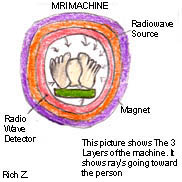
St. Mary's High School, Manhasset, NY
|
** Important Disclaimer ** |
||||||
MRI - The Magnetic Lifesaver
Karina J.
MRI stands for Magnetic Resonance Imaging. That's just a fancy term for using a device with magnets to see inside a person in order to identified an illness. It is a large machine that can either be open (the person is not surrounded by the machine) or closed (the machine completely surrounds the person). A doctor at a hospital operates it. This device is important because it can identify an illness before they become too serious to cure. The illnesses that the machine identifies have to do with the brain or spine.

The test is done by sliding a person into a round tube and taking pictures of the inside of the personís bone or brain. The pictures that the machine takes are then put onto a screen for a doctor to examine. The test has no bad side effects, except on your wallet. It may cost up to $1,300! (circa 1998) There are people who should not take an MRI. These people might include people who are afraid of small spaces (claustrophobic), people with a pacemaker (a device that maintains your heartbeat), or people with implants in their brains.
MRI is a powerful way of getting various pictures of the body without using x-rays. How is this done, may you ask? This is done by magnetism. A MRI scanner consists of large and very strong magnets that send radio signals into the body. Radio signals are also returned from the body, which produces pictures. Thatís how magnetism is used in MRI. The magnetic field in the MRI machine is very powerful.